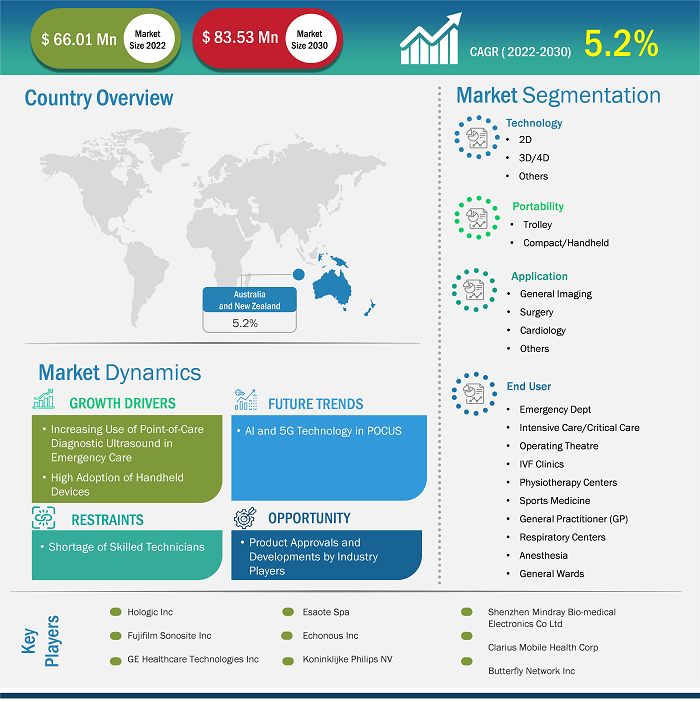2D Held Largest Share of Technology Segment in Australia and New Zealand Point-of-Care Diagnostic Ultrasound Market
According to our new research study on "Australia and New Zealand Point-of-Care Diagnostic Ultrasound Market Forecast (2020–2030), Country Share, Trend, and Growth Opportunity Analysis – by Technology, Portability, Application, and End User," the Australia and New Zealand point-of-care diagnostic ultrasound market size was valued at US$ 66.01 million in 2022 and is expected to reach US$ 83.53 million by 2030. It is estimated to register a CAGR of 5.24% from 2022 to 2030. The increasing use of point-of-care diagnostic ultrasound in emergency care and the high adoption of handheld devices are the major factors contributing to the growing Australia and New Zealand point-of-care diagnostic ultrasound market size. Furthermore, the growing incidence of chronic diseases is also expected to act as one of the major drivers for the Australia and New Zealand point-of-care diagnostic ultrasound market forecast. However, the shortage of skilled technicians is the major factor hindering the market growth.
In terms of application, the Australia and New Zealand point-of-care diagnostic ultrasound market is categorized into general imaging, cardiology, surgery, and others. The cardiology segment held the largest Australia and New Zealand point-of-care diagnostic ultrasound market share in 2022. The general imaging segment is anticipated to register the highest CAGR during 2022–2030. In cardiology, a bedside cardiac ultrasound or echocardiogram is a quick POCUS that allows the visualization and assessment of heart function. The cardiac ultrasound procedure is also known as echocardiography and echocardiogram. Bedside echocardiography can assist in evaluating hemodynamic changes and pathological heart diseases. Real-time 3D echocardiography test was proposed to visualize the anatomy of the cardiac chambers entirely in real time. Real-time 3D echocardiogram is increasingly utilized to accurately measure left ventricular volume and dynamic changes in chamber volume during the cardiac cycle. It provides functional information, for instance, blood flow and ejection fractions, to diagnose ischemic and congenital heart disease.
Australia and New Zealand Point-of-Care Diagnostic Ultrasound Market Size and Forecast (2020 - 2030), Regional Share, Trend, and Growth Opportunity Analysis Report Coverage: By Technology (2D, 3D/4D, and Others), Portability (Trolley and Compact/Handheld), Application (General Imaging, Surgery, Cardiology, and Others), and End User (Emergency Department, Intensive Care Critical Care, Operating Theatre, IVF Clinics, Physiotherapy Centers, Sports Medicine, General Practitioner, Respiratory Center, Anesthesia, and General Wards)
Australia and New Zealand Point-of-Care Diagnostic Ultrasound Market Growth 2030
Download Free Sample
Cardiac ultrasound can also be referred to as “Transthoracic” or “Transesophageal” echocardiography. Using bedside echocardiogram is one of the most useful POCUS applications. It can help assess the hemodynamic status of patients, estimate fluid status, and inspect life-threatening causes of shock such as tamponade or pulmonary embolism. Thus, the above-mentioned factors support the Australia and New Zealand point-of-care diagnostic ultrasound market growth.
Based on technology, the market is segmented into 2D, 3D/4D, and others. The 2D segment held the largest in Australia and New Zealand point-of-care diagnostic ultrasound market share in 2022. In ultrasound, B-Mode is a setting that creates a two-dimensional (2D) greyscale image on the ultrasound screen and is the most used mode. It is generally called 2D mode. The 2D ultrasound systems are readily available in the market and are affordable. Generally, 2D ultrasound is used to diagnose the health of the fetus in pregnant women. It produces a black-and-white image that shows the skeletal structure of the baby and makes the internal organs visible. The 2D image produced by point-of-care ultrasound (POCUS) allows healthcare professionals to visualize organs, blood vessels, and other structures in real time, helping with diagnosis and guiding procedures. 2D ultrasound is easier to use, time-efficient, and cost-effective compared to other technologies. In addition, advanced image quality and rapid results lead to the usage of this technology in diagnostic centers.
The 3D/4D segment is anticipated to register the highest CAGR in the Australia and New Zealand point-of-care diagnostic ultrasound market during 2022–2030. The 3D and 4D technologies provide a more detailed and realistic representation of the body's internal structures compared to 2D imaging. Real-time 3D and 4D ultrasound systems are identical to 3D ultrasound systems; the only difference is that they give output in real time, and the ultrasound being performed can be seen live on the screen. A portable 3D ultrasound is a compact and lightweight medical imaging device that is easy to transport and use in various settings, such as hospitals, clinics, or even remote or difficult-to-access locations. The 3D/4D ultrasound has many features and capabilities of a larger, stationary ultrasound machine but is designed to be more flexible and convenient to use. It can be used in the visualization of embryonic movements up to two weeks before 2D ultrasound. These portable ultrasound systems are convenient and flexible options for medical professionals, allowing medical personnel to provide high-quality imaging services in different settings while offering mobility and accessibility that is not possible with a larger and stationary machine. Therefore, the growing use of 3D and 4D technologies is projected to positively impact the Australia and New Zealand point-of-care diagnostic ultrasound market forecast.
GE Healthcare; Butterfly Network, Inc.; Fujifilm; Esoate SpA; Hologic, Inc.; Echonous Inc.; Koninklijke Philips NV; Shenzhen Mindray Bio-medical Electronics Co Ltd; and Clarius Mobile Health Corp. are among the leading companies that are favoring the Australia and New Zealand point-of-care diagnostic ultrasound market growth.
The report segments the market as follows:
The Australia and New Zealand point-of-care diagnostic ultrasound market is segmented into technology, portability, application, and end user. Based on technology, the market is segmented into 2D, 3D/4D, and others. By portability, the market is bifurcated into trolley and compact/handheld. In terms of application, the market is categorized into general imaging, cardiology, surgery, and others. Based on end user, the Australia and New Zealand point-of-care diagnostic ultrasound market is segmented into emergency, intensive care/critical care, operating theater, IVF clinics, physiotherapy centers, sports medicine, general practitioners, respiratory centers, anesthesia, and general wards.
Contact Us
Phone: +1-646-491-9876
Email Id: sales@theinsightpartners.com